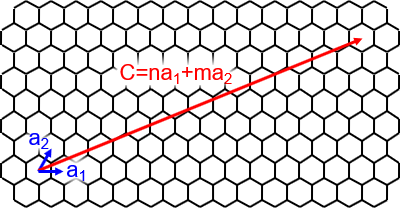Research:Chirality of single-walled carbon nanotubes
A sheet made of carbon atoms arranged in a honeycomb lattice is known as graphene. Single-walled carbon nanotubes have the structure of a tube made by rolling up such a graphene sheet, and they typically have a diameter of few nanometers. In order to form a seamless tube, you would need to take two of the hexagons in a graphene lattice and overlap them. A vector connecting the centers of the two hexagons is called the chiral vector, and it determines the structure of a single-walled carbon nanotube.

Chiral vector C can be written as C = n a1 + m a2 where a1 and a2 are basis vectors of the graphene lattice. The pair of integers (n,m) is called the chiral index or just chirality. This implies that the structure of a single-walled carbon nanotube is completely determined by chirality.
The most interesting aspect of single walled carbon nanotubes is that their electronic structure can become either semiconducting or metallic depending on the chirality, and it is also interesting that the bandgap energy also depends on chirality. Unfortunately, it is difficult to control the chirality when we synthesize carbon nanotubes. Nevertheless, measurements on individual nanotubes can clarify the different characteristics that depend on the chirality.